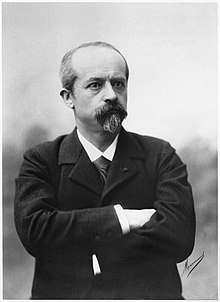Louis Lépine
| Louis Lépine | |
|---|---|

Louis Lépine
|
|
| Born |
August 6, 1846 Lyon |
| Died | November 9, 1933 (aged 87) Paris |
| Other names | The Little Man with the Big Stick, The prefect of the street |
| Relatives | Raphaël Lépine |
| Awards | Médaille militaire |
| Police career | |
| Allegiance | France |
| Years of service | 1871–1913 |
| Rank | Préfet de Police |
Louis Jean-Baptiste Lépine was a lawyer, politician and inventor who was Préfet de Police with the Paris Police Prefecture from 1893 to 1897 and again from 1899 to 1913. He earned the nickname of "The Little Man with the Big Stick" for his skill in handling large Parisian crowds. He was responsible for the modernisation of the French Police Force. Under Lépine the study of forensic science as a tool of detection became standard practise.
Louis Lépine studied law in his home city of Lyon and in Paris and Heidelberg. He served with distinction in the French Army during the Franco-Prussian War from 1870 to 1871. Serving as a sergeant major at Belfort in the Alsace region, his unit was besieged and continually attacked by the Prussians. It surrendered only after the hostilities had ceased.
Lépine was awarded the Médaille militaire for his bravery. He then embarked on a career as a lawyer and public administrator, a successful career that took in provincial postings that included deputy prefect of Lapalisse, Montbrison, Langres and Fontainebleau and then prefect of the Indres, the Loire and Seine-et-Oise.
In 1893 Lépine became prefect of police of the Seine (Paris) at a time when Paris and indeed France was politically volatile. The perceived failure of the previous Prefect Henri-Auguste Lozé to quell serious student riots in 1893 resulted in Lépine’s appointment. The riots that had taken place arose out of a trivial incident involving the arrest of an actress Sarah Brown, a student called Nuger and a confrontation with a policeman, the consequence of which was the death of Nuger. On the following Monday, 1,000 demonstrators marched onto the Chamber of Deputies, determined to be provided with an adequate explanation. The Deputies summarily retreated and by the evening a further 1,000 students were outside and by now the mood of the demonstrators had turned hostile. At the end of the day barricades were erected around the district of the Boulevard Saint-Germain.
The police had lost control of the situation and the National Guard was called in to regain control. There followed several days of bloodshed as several important workers’ organisations sided with the so-called students. Within five days of the arrest of Sarah Brown, the students were submerged within a violent mob that was ready to fight for control of Paris.
...
Wikipedia
